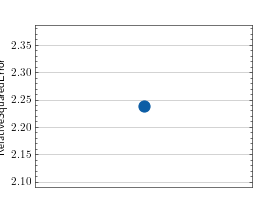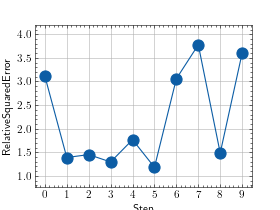Relative Squared Error (RSE)¶
Module Interface¶
- class torchmetrics.RelativeSquaredError(num_outputs=1, squared=True, **kwargs)[source]¶
Computes the relative squared error (RSE).
\[\text{RSE} = \frac{\sum_i^N(y_i - \hat{y_i})^2}{\sum_i^N(y_i - \overline{y})^2}\]Where \(y\) is a tensor of target values with mean \(\overline{y}\), and \(\hat{y}\) is a tensor of predictions.
If num_outputs > 1, the returned value is averaged over all the outputs.
As input to
forwardandupdatethe metric accepts the following input:preds(Tensor): Predictions from model in float tensor with shape(N,)or(N, M)(multioutput)target(Tensor): Ground truth values in float tensor with shape(N,)or(N, M)(multioutput)
As output of
forwardandcomputethe metric returns the following output:rse(Tensor): A tensor with the RSE score(s)
- Parameters:
Example
>>> from torchmetrics.regression import RelativeSquaredError >>> target = torch.tensor([3, -0.5, 2, 7]) >>> preds = torch.tensor([2.5, 0.0, 2, 8]) >>> relative_squared_error = RelativeSquaredError() >>> relative_squared_error(preds, target) tensor(0.0514)
- plot(val=None, ax=None)[source]¶
Plot a single or multiple values from the metric.
- Parameters:
val¶ (
Union[Tensor,Sequence[Tensor],None]) – Either a single result from calling metric.forward or metric.compute or a list of these results. If no value is provided, will automatically call metric.compute and plot that result.ax¶ (
Optional[Axes]) – An matplotlib axis object. If provided will add plot to that axis
- Return type:
- Returns:
Figure and Axes object
- Raises:
ModuleNotFoundError – If matplotlib is not installed
>>> from torch import randn >>> # Example plotting a single value >>> from torchmetrics.regression import RelativeSquaredError >>> metric = RelativeSquaredError() >>> metric.update(randn(10,), randn(10,)) >>> fig_, ax_ = metric.plot()

>>> from torch import randn >>> # Example plotting multiple values >>> from torchmetrics.regression import RelativeSquaredError >>> metric = RelativeSquaredError() >>> values = [] >>> for _ in range(10): ... values.append(metric(randn(10,), randn(10,))) >>> fig, ax = metric.plot(values)

Functional Interface¶
- torchmetrics.functional.relative_squared_error(preds, target, squared=True)[source]¶
Computes the relative squared error (RSE).
\[\text{RSE} = \frac{\sum_i^N(y_i - \hat{y_i})^2}{\sum_i^N(y_i - \overline{y})^2}\]Where \(y\) is a tensor of target values with mean \(\overline{y}\), and \(\hat{y}\) is a tensor of predictions.
If preds and targets are 2D tensors, the RSE is averaged over the second dim.
- Parameters:
- Return type:
- Returns:
Tensor with RSE
Example
>>> from torchmetrics.functional.regression import relative_squared_error >>> target = torch.tensor([3, -0.5, 2, 7]) >>> preds = torch.tensor([2.5, 0.0, 2, 8]) >>> relative_squared_error(preds, target) tensor(0.0514)
